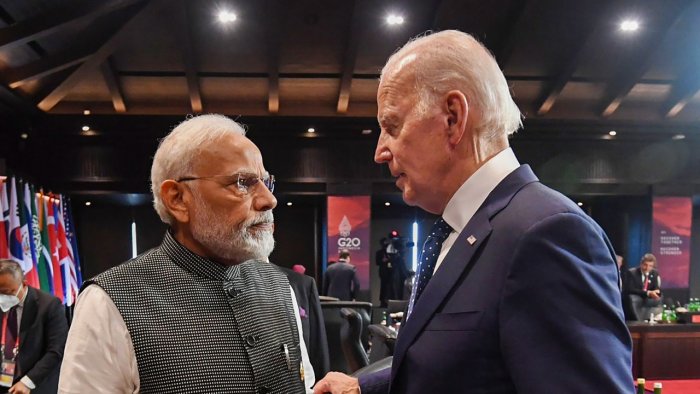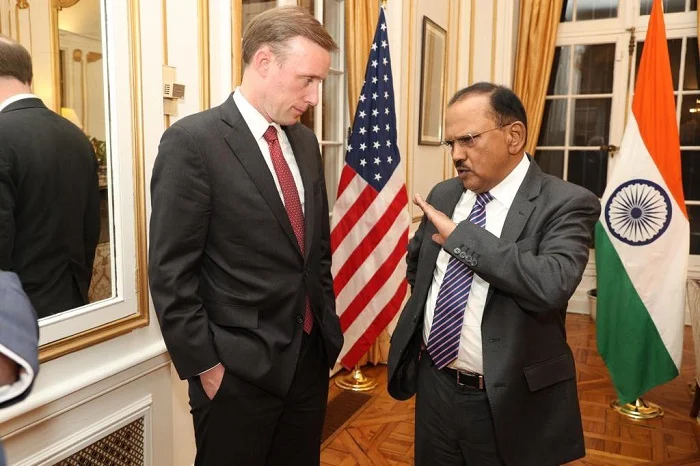

The geopolitical environment dictates India to play its cards with maturity in order not to become a victim of the aggressive behaviour of adversaries
Inking of India-US roadmap for military-industrial cooperation was not surprising after the spat at Shangri La dialogue between Secretary Defence Lloyd Austin and China’s Defence Minister Li Shangfu.
It was not unexpected since the manner in which the tension in the South China Sea has been building up in the last few years, the US-China relations could only have headed south. Clearly, supremacy in the Indo- Pacific will be prerequisite to the future of world order.
US-India cooperation needs to be seen through that prism. Despite India’s divergent views with the US on a few major issues, the US has come to the conclusion that India’s economic and military power enhancement is key to retaining a ‘free and open sea’, ‘adherence to rule-based order’ in the larger Indo-Pacific.
Not only India is a strong and largest democracy but it also shares values of ‘democracy’ and ‘freedom’ with the US. On China, both countries have found a common cause and often reminded Beijing that expansionism and breaching of sovereignty will not be acceptable by the free world. In the absence of a strong UN, multilateral groupings have become significant contributors to world peace and stability.
The geopolitical environment dictates India to play its cards with maturity in order not to become a victim of the aggressive behaviour of adversaries. With the repeated failure of Ladakh border talks and sporadic infiltration of terrorists from across the Line of Control, it is prudent for India to keep sharpening its arsenal with advanced technologies. The two-front threat from two nuclear neighbours is compounded by their collusion and now the Russia-China connection due to the Ukraine conflict requires a reorientation of India’s defence supplier relationship. US-led sanctions have their own implication on Russian imports. Also, in the event of a hot war on the northern/eastern border, Russia will find it difficult to support India due to its alliance with China. It is time for India to acquire technologies that it does not possess.


The visit by NSA Ajit Doval to DC and meeting Jake Sullivan, NSA at the White House and finalizing ICET (Initiative on Critical and Emerging Technology) must be seen as White House consent for the US Administration to move ahead with negotiations. It may be recalled that DTTI (Defence Technology and Trade Initiative) had yielded no results and many hurdles came on the way. Essentially, in the US system, major strategic activities between countries need White House consent before the ministerial-level agreement. This time India has been methodical and credit must go to PM Modi’s points-man Ajit Doval. Thereafter, the process began with a two days visit by Secretary Lloyd Austin, accelerated by events at Shangri La.
The finalisation of Defence Industrial Cooperation Roadmap is consequential to many factors. The time is also right since PM Modi has been invited as the State Guest by President Biden, a rare honour indeed. This will provide an appropriate plank for official announcements.
The ambitious roadmap will fast-track the existing collaboration and co-production and commence in the areas of futuristic weapon systems and platforms. The list is long and addresses some of the very critical technologies for all three services.
Another important point made by Honourable Raksha Mantri Rajnath Singh was that Pakistan cannot be trusted with Western military equipment and platforms as they could share it with China and result in subsequent reverse engineering.
Discussions hovered around India’s military capacity building to ensure greater maritime and underwater domain awareness, strategic infrastructure and logistics besides future collaboration on a range of defence technologies with an emphasis on the underwater domain. Other areas that are very significant as far as future technologies are concerned, range from air combat, infantry combat vehicles and ISR (intelligence, surveillance, reconnaissance) systems to long-range artillery, smart munitions and underwater domain awareness.
For the immediate, the talks between GE (General Electrics) and HAL Engine Division have already commenced for jointly producing GE-F414 turbofan engines in the 98 Kilonewton thrust category, a serious shortcoming for India which has discouraged HAL from manufacturing fighter aircraft for 7 decades. This technology would give tremendous impetus to the Tejas programme which is fitted with F 404 engine with much lower thrust. It must be noted that China has reverse-engineered Russian jet engines and successfully built all its fighter aircraft and now the engines for its commercial aircraft C-919 which recently made its first passenger flight.
Subsequent technology transfer for Stryker armoured fighting vehicles, long-range artillery and ISR systems are in the process of discussion.
Another significant proposal made by India is ToT and MRO facilities for Predator or MQ-9B Sea Guardian drones which are long pending for procurement.
There was an agreement between both sides for collaborating even more closely in support of their shared vision for a free, open and inclusive Indo-Pacific. There is an agreement on strengthening operational collaboration across all three services with the aim to support India’s leading role as a security provider in the Indo-Pacific.
In essence, this agreement on the roadmap reflects deepening the India-US partnership by way of growing military cooperation between the two great powers which can become a force for global good. The entire paradigm of cooperation is headed for quantitative and qualitative transformation.
There is broader agreement on the US becoming a trusted source of resilient supply chains and greater industry-to-industry partnership.
To achieve the objectives the two leaders have agreed to review regulatory hurdles impeding closer industry-to-industry cooperation and initiate negotiations on a Security of Supply arrangements and Reciprocal Defence Procurement agreement which would promote long-term supply chain stability.
Honourable RM also pointed to the US to increase sourcing of parts from India in the context of the Air India Boeing deal. MRO for equipment in use in India should be looked at. India has offered ship repair and maintenance to USN and has even greater capacity, so the US could increase the numbers in future.
While the expressions in the agreement have a far-reaching positive impact on India’s military power and its overall strategic ability to maintain peace and stability in the Indo-Pacific, it is necessary to institutionalize the agreements into a letter of proposal from India and letter of acceptance by the US to convert these in contractual format. That alone will be the proof of the pudding.
(Vice Admiral Shekhar Sinha is the former Commander-in-Chief of the Western Naval Command, and trustee at the India Foundation. Views expressed are personal and exclusive to India Narrative)
Also Read: Vikrant’s commissioning will cement India’s Indo-Pacific thrust
Prime Minister Narendra Modi-chaired CCEA, in a meeting on Wednesday, granted enhanced autonomy to Maharatna…
Baloch activists Dr. Naseem Baloch, Chairman of the Baloch National Movement (BNM), while speaking at…
Union Commerce and Industry Minister Piyush Goyal met with deeptech startups and discussed ways to…
Taiwan's Ministry of National Defence (MND) stated that it had detected 18 Chinese military aircraft,…
External Affairs Minister S Jaishankar on Tuesday called on member nations of the Shanghai Cooperation…
External Affairs Minister S Jaishankar held a meeting with his Russian counterpart, Sergey Lavrov, on…